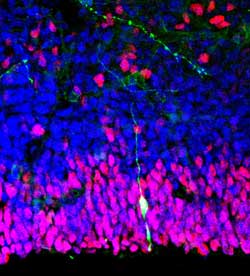The making and unmaking of stem-like, aggressive breast cancer cells

Reverting to a stem-like state, as shown here, helps breast cancer cells evolve around the blockages of current treatments. Image: Flickr/CodonAUG cc license.<br>
A University of Colorado Cancer Center study published as a featured article in the journal Oncogene shows how progesterone does just this – by suppressing a key microRNA, progestins return breast cancer cells to a stem-cell-like state in which they haven’t yet differentiated, and are thus more resistant to chemotherapies and more likely to carry a poor prognosis.
“The reason we were looking into the possible role of microRNAs in the dedifferentiation of breast cancer cells into this aggressive, chemo-resistant phenotype is that microRNAs tend to be good, druggable targets. Because one microRNA may regulate many genes involved in a cancerous signaling pathway, we hoped to find one target with many beneficial effects,” says Diana Cittelly, PhD, postdoctoral fellow at the CU Cancer Center and the paper’s first author. The study was a collaboration between the CU Cancer Center labs of Jennifer Richer, PhD, and Carol Sartorius, PhD.
Specifically, the study shows that progestins regulate miRNA-29 – a molecule that helps to decide which of a cell’s genes are and are not turned into proteins. This regulation of miRNA-29 creates a cascade that stimulates breast cancer cells to revert back to a stem-like state, marked by proteins CD44 and CK5. In animal models, these stem-like cells helped breast cancer evolve around the blockages of current treatments..
“We can manipulate this miRNA-29 in cell lines,” Cittelly says, “and we hope technology isn’t too far in the future that will allow us to deliver miRNA-29 in human cancers as well.”
Turn off the role of miRNA-29 and the hope is that breast cancers won’t be able to gain stem cell-like traits and lose their hormone dependence.
This work was supported by DOD BCRP Postdoctoral Fellowship W81XWH-11-1-0101 and DOD Idea Award BCRP W81XWH-11-1-0210.
Media Contact
More Information:
http://www.ucdenver.eduAll latest news from the category: Life Sciences and Chemistry
Articles and reports from the Life Sciences and chemistry area deal with applied and basic research into modern biology, chemistry and human medicine.
Valuable information can be found on a range of life sciences fields including bacteriology, biochemistry, bionics, bioinformatics, biophysics, biotechnology, genetics, geobotany, human biology, marine biology, microbiology, molecular biology, cellular biology, zoology, bioinorganic chemistry, microchemistry and environmental chemistry.
Newest articles

Superradiant atoms could push the boundaries of how precisely time can be measured
Superradiant atoms can help us measure time more precisely than ever. In a new study, researchers from the University of Copenhagen present a new method for measuring the time interval,…

Ion thermoelectric conversion devices for near room temperature
The electrode sheet of the thermoelectric device consists of ionic hydrogel, which is sandwiched between the electrodes to form, and the Prussian blue on the electrode undergoes a redox reaction…

Zap Energy achieves 37-million-degree temperatures in a compact device
New publication reports record electron temperatures for a small-scale, sheared-flow-stabilized Z-pinch fusion device. In the nine decades since humans first produced fusion reactions, only a few fusion technologies have demonstrated…





















